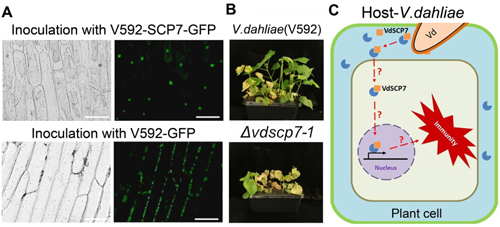Verticillium dahliae (V. dahliae) is a soil borne fungal pathogen that infects a broad range of hosts. It is now becoming a major threat to many economically important crops, such as cotton and sunflower. Similar to most filamentous pathogens, V. dahliae secretes effector proteins to overcome plant basal defense for successful host colonization. Resistance plants can recognize effector by cognate R proteins to induce a second layer of immunity (known as effector-triggered immunity, ETI) against pathogen infection. However, very few R proteins were found to recognize V. dahliae effectors and trigger ETI.
The research group led by Prof. GUO Hui-Shan at State Key Lab of Plant Genomics, Institute of Microbiology, Chinese Academy of Sciences (IMCAS) has been working on V. dahliae pathogenesis and crop resistance against wilt diseases for over ten years.
Recently, they discovered a Verticillium-specific protein, namely VdSCP7, that functions as an effector and alters plant susceptibility to fungal and oomycete infection.VdSCP7 was selected by proteomic analysis of the cultural filtrate from a cotton-isolated V. dahliae strain (V592). The protein contains N-terminal signal peptide and a nuclear localization signal that is secreted by V. dahliae and accumulates in the plant nucleus (Fig. A). Expression of VdSCP7 in Nicotiana benthamiana induced immune responses such as ROS accumulation, callose deposition and HR.
Interestingly, VdSCP7-expressing N. benthamiana leaves showed resistance to the fungal pathogen Botrytis cinerea but enhanced susceptibility to the oomycete pathogen Phytophthoracapsici. VdSCP7 gene knockout mutants showed enhanced virulence in cotton host, suggesting that there is a cognate R-gene in cotton that has triggered immunity against Verticillium infection (Fig. B).
They proposed a model that VdSCP7 could activate plant immunity by translocation from apoplastic space to the nucleus (Fig. C). VdSCP7 is the first discovered nuclear effector in Verticillium species.
The detailed results of VdSCP7 have been published in New Phytologist (http://onlinelibrary.wiley.com/doi/10.1111/nph.14537/epdf) with Dr. ZHANG Lisha and Dr. NI Hao as joint first authors, and Prof. GUO Hui-Shan and Dr. HUA Chenlei as corresponding authors.
The research was financially supported by grants from the Strategic Priority Research Program of the Chinese Academy of Sciences to Prof. GUO Hui-Shan, and grants from National Natural Science Foundation and Chinese Scholarship Council to Dr. HUA Chenlei.

Fig. A. GFP-tagged VdSCP7 is secreted by V. dahliae and accumulates in the plant nucleus. Fig. B. VdSCP7 gene knockout mutant (?vdscp7-1) showed enhanced virulence in cotton host. Fig. C. Hypothesis of VdSCP7 activating plant immunity by translocation from apoplastic space to the nucleus. (Image by Prof. GUO’s group)
Contact
Prof. GUO Hui-Shan
Institute of Microbiology, Chinese Academy of Sciences
E-mail: guohs@im.ac.cn